Zuo-Guang. Ye Advanced Dielectric Piezoelectric and Ferroelectric Materials: Synthesis, Characterisation and Applications
Подождите немного. Документ загружается.

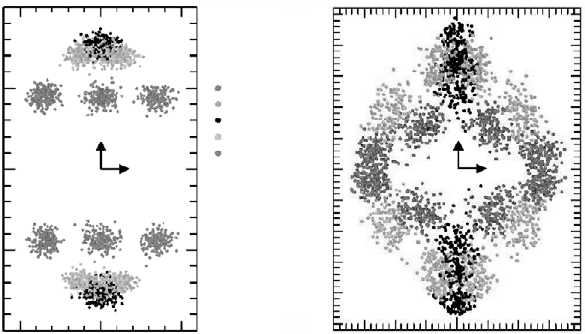
Handbook of dielectric, piezoelectric and ferroelectric materials580
thick PZT film, but with the average magnitude of the dipoles having been
rescaled (with respect to that of the PZT film) in order to be identical to that
of fully relaxed BTO films. As a result, BTO
PZT
-010-8 exhibits continuously
rotating dipoles across a given stripe and in-plane surface dipoles, as in the
equilibrium domain pattern of PZT but unlike in BTO-110-4.3. Interestingly,
BTO
PZT
-010-8 is found to be thermodynamically unstable because it directly
transforms into another domain structure, having no significantly rotating or
in-plane dipoles, after a couple of MC sweeps. BTO films thus profoundly
dislike significantly rotating and in-plane dipoles. Such disliking takes a
major part of its origin in the strain-soft mode interaction energy, E
int
. In
other words, the local soft modes in BTO prefer to follow the easy polarization
z-axis introduced by the elastic compressive strain. (In contrast, we numerically
found that E
short
becomes the predominant contributing factor for the PZT
domain patterns to exhibit rotating dipoles across stripes.)
19.3.3 Domain evolution under electric field
The aim of this subsection is to summarize recent first-principles-based
works (Lai et al., 2006, 2007) that revealed, as well as provided detailed
–0.025 0.0 0.025
(a)
0.050
0.025
0.0
–0.025
–0.050
z
[1–10]
Layer 1
Layer 2
Layer 3
Layer 4
Layer 5
z
y
0.10
0.05
0.0
–0.05
–0.10
–0.1 –0.05 0.0 0.05 0.1
(b)
19.3
Real-space distribution of the local modes in (a) BTO-110-4.3
and (b) PZT-010-8 films. These films possess five (001) B-layers, or
equivalently, have a thickness of around 20Å. The X and 䉫 symbols
correspond to the surface B-layers, while the • symbol characterizes
the dipoles at the most inner layer. The 䊐 and 䊊 symbols refer to the
other two (001) planes (located between the surface and most-inner
layers). Vertical and horizontal axes (in both (a) and (b) parts)
represent the projection of the local modes (given in atomic units)
along the
z
-axis and stripe alternating direction, respectively.
(Reprinted with permission from Lai
et al.
, 2007).
WPNL2204
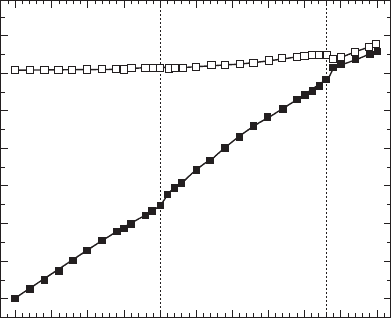
Domains in ferroelectric nanostructures from first principles 581
atomistic features of, the stripe domains’ evolution in [001] PbZr
0.5
Ti
0.5
O
3
and [001] BaTiO
3
ultra-thin films under an external electric field applied
along the [001] direction (chosen to be the z-axis). In the following, the
magnitude of this field is denoted as E
z
.
Domain evolution in PbZr
0.5
Ti
0.5
O
3
films
Figure 19.4 shows the supercell average of the z-Cartesian component of the
local modes 〈u
z
〉 and of the magnitude of the local modes 〈u
M
〉 as a function
of E
z
in 20 Å-thick PbZr
0.5
Ti
0.5
O
3
ultrathin films (as mimicked by a 40 × 20
× 5 supercell), as predicted by the effective Hamiltonian technique (Lai et
al., 2006). The temperature is 10K and the misfit (compressive) strain is
2.65%. We chose here a realistic electrical boundary condition (Streiffer et
al., 2002; Junquera and Ghosez, 2003), which corresponds to an 81% screening
of the maximum depolarizing field. As consistent with Streiffer et al. (2002)
and Kornev et al., 2004) and as discussed above, the combination of a
compressive epitaxial strain with a large enough residual depolarizing field
leads to the formation of 180° stripe domains, when no external electric field
is applied. Figure 19.5(a) displays such domains that adopt a periodicity of
eight unit cells (32Å) for the considered 20Å-thick ultra-thin film. Inside
0 5 10 15 20 25 30 35 40 45 50
E
z
(10
7
V/m)
Local modes (a.u.)
0.08
0.07
0.06
0.05
0.04
0.03
0.02
0.01
0.00
19.4
Supercell average of the
z
-Cartesian component of the local
modes, <
u
z
>, and supercell average of the magnitude of the local
modes, <
u
M
>, as a function of the
E
z
, applied electric field along the
z
-axis for 20 Å-thick Pb(Zr
0.5
Ti
0.5
)O
3
films under a compressive strain
of –2.65%, a 81% screening of the maximum depolarizing field, and
at
T
= 10 K. Kinks in the curves reflect changes in the dipole pattern.
Open and solid symbols display <
u
M
> and <
u
z
>, respectively.
(Reprinted with permission from Lai
et al.
, 2006).
WPNL2204
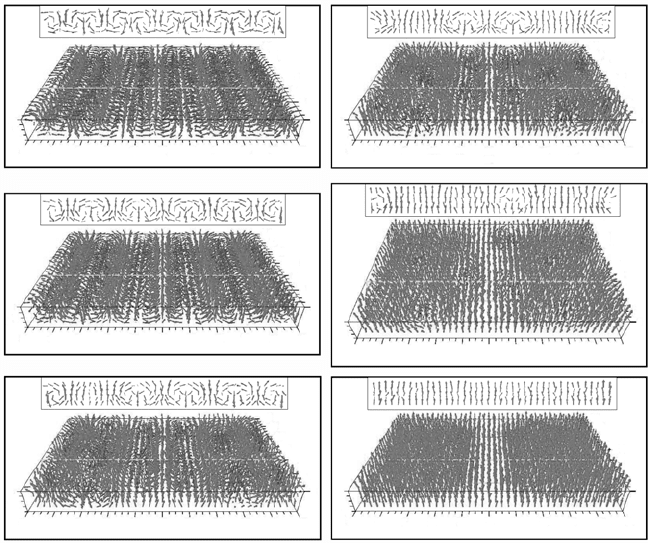
Handbook of dielectric, piezoelectric and ferroelectric materials582
each period, two stripe domains with (mostly) opposite out-of-plane dipoles
which we will refer to as ‘up’ and ‘down’ domains alternate along the x axis.
(Note that, as discussed above, dipoles lying in plane can also be found at the
top and bottom surfaces to further minimize the residual depolarizing field.)
The up and down domains can be considered as each having an equal width
of four unit cells for E
z
= 0, explaining why 〈u
z
〉 vanishes while 〈u
M
〉 is
significantly larger than zero (see Fig. 19.4). Furthermore, Figs 19.5(b)–(f)
provide atomistic detail on the evolution of the dipole patterns of the film, as
given by the last snapshot of our MC simulations, when activating and
increasing an applied electric field.
Figure 19.6 provides complementary information on the number of supercell
sites having a positive or negative z component of their dipoles, as well as on
the average magnitude of such dipoles in the different (001) planes, as a
(a)
(d)
(b)
(e)
(c) (f)
z
y
5
3
1
0 4 8 1216202428323640
x
24
20
16
12
8
4
0
z
y
5
3
1
0 4 8 1216202426323640
x
24
20
16
12
8
4
0
z
y
5
3
1
0 4 8 1216202428323640
x
24
20
16
12
8
4
0
z
y
5
3
1
0 4 8 1216202428323640
x
24
20
16
12
8
4
0
y
5
3
1
0 4 81216202426323640
x
24
20
16
12
8
4
0
z
y
5
3
1
0 4 81216202428323640
x
24
20
16
12
8
4
0
z
19.5
T
=10 K three-dimensional polarization patterns in (001)
Pb(Zr
0.5
Ti
0.5
)O
3
films under different
E
z
fields: stripe domains under
(a)
E
z
= 0 and (b)
E
z
= 18 × 10
7
V/m; bubble domains under (c)
E
z
= 25
× 10
7
, (d)
E
z
= 31 × 10
7
and (e)
E
z
= 43 × 10
7
V/m; and monodomain
under (f) E
z
= 47 × 107 V/m. The insets show the cross-sections of a
specific (
x, z
) plane. Light (dark) arrows characterize local dipoles
having a positive (negative) component along the
z
-axis. (Reprinted
with permission from Lai
et al.
, 2006).
WPNL2204
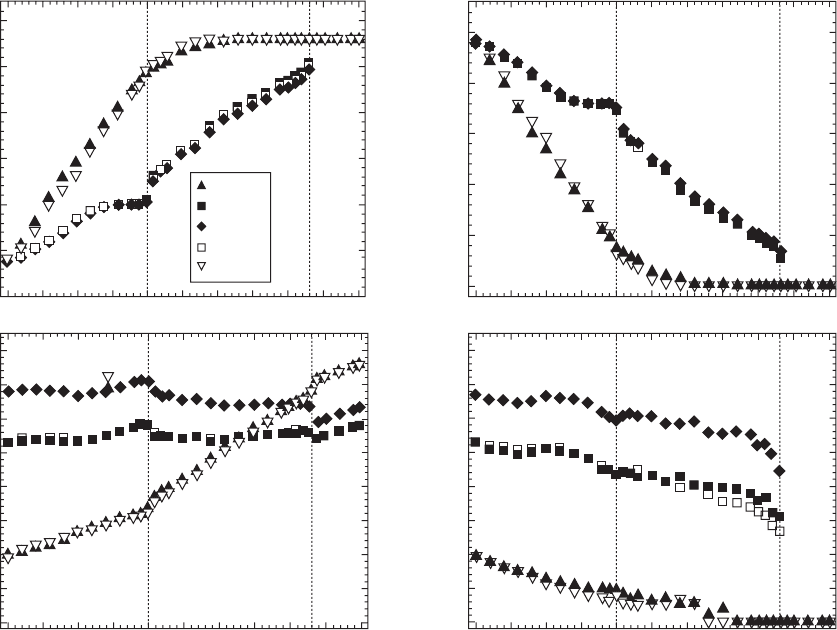
Domains in ferroelectric nanostructures from first principles 583
Layer 1
Layer 2
Layer 3
Layer 4
Layer 5
Number of sites with
u
z
> 0
1000
900
800
700
600
500
400
(a)
Stripe
Bubble
Mono
0 5 10 15 20 25 30 35 40 45 50
<|
u
z
|>
0.08
0.07
0.06
0.05
0.04
0.03
0.02
0.01
0.00
(b)
Stripe
Bubble
Mono
0 5 10 15 20 25 30 35 40 45 50
E
z
(10
7
V/m)
<|
u
z
|>
0.08
0.07
0.06
0.05
0.04
0.03
0.02
0.01
0.00
(d)
Stripe
Bubble Mono
0 5 10 15 20 25 30 35 40 45 50
E
z
(10
7
V/m)
Number of sites with
u
z
> 0
500
400
300
200
100
0
(c) Stripe Bubble
Mono
0 5 10 15 20 25 30 35 40 45 50
19.6
(a) Number of sites
with a positive
z
-
Cartesian component of
the local modes and (b)
the corresponding <|
u
z
|>
average magnitude of
their
z
-Cartesian
component of the local
modes, as a function of
E
z
, in the different (001)
layers of the
Pb(Zr
0.5
Ti
0.5
)O
3
film at
T
=10 K. (c) and (d) are
the same as (a) and (b),
respectively, but for a
negative
z
-Cartesian
component of the local
modes. The layer index
of thin films from the
first layer (layer 1,
which is a surface layer)
to the last layers (layer
5, which is the other
surface layer) are
indicated via solid
triangle, solid square,
solid diamond, open
square and reversed
open triangle,
respectively. (Reprinted
with permission from
Lai
et al.
, 2006).
WPNL2204
Handbook of dielectric, piezoelectric and ferroelectric materials584
function of E
z
. Figures 19.4 and 19.6 indicate that, when E
z
increases from
zero to 20 × 10
7
V/m, 〈u
z
〉 linearly increases while 〈u
M
〉 barely increases,
because some sites rotate and flip their local dipoles towards E while very
slightly increasing their magnitude. Comparing Figs 19.5(a) and (b) reveals
that such rotation and flip occur near the domain walls separating the up and
down nanodomains. The up domains (i.e. for which the dipoles have a z
component aligned along E) thus grow laterally at the cost of the adjacent
down (antiparallel) domains. Interestingly, the studied thin films still adopt
a periodic stripe domain structure, with the overall periodicity remaining
unchanged, during that lateral growth process. Figures 19.5(b), 19.6(a) and
19.6(c) also indicate that, at the surfaces, the number of dipoles with in-
plane components is reduced with respect to the E
z
= 0 case in favor of dipoles
having a positive z component. At the critical value E
z
= 20 × 10
7
V/m, the
average width of the up and down domains is numerically found to be five
and three lattice constants, respectively. As E
z
keeps increasing above 20 ×
10
7
V/m, a slight change in the slope of the 〈u
z
〉 versus E
z
curve occurs (see
Fig. 19.4), which is associated with the occurrence of the structural modification
seen in Fig. 19.5(c): the smaller down domains become pinched along the y
direction (which is parallel to the [010] direction) and three-dimensional
nanobubbles (having dipoles still being antiparallel to the applied field) now
emerge from this pinching. Such bubbles are elongated along the y direction
and have a width of three lattice constants along the x-axis (which is parallel
to the [100] direction), as direct consequences of the breaking of the previous
down stripe domains along the y direction.
As revealed by Figs 19.6(a) and (c), the transition from stripe-to-bubble
domains is accompanied by a sudden and discontinuous increase (respectively,
decrease) of the number of sites belonging to the inner layers with positive
(respectively, negative) z components for their dipoles. A minimal lateral (x)
size of down domains of three lattice constants (12Å), below which a periodic
stripe domains structure cannot be stable anymore, thus exists in our 20Å-
thick films (see Figs 19.5b and c). Interestingly, when the down stripe domains
reach such a minimal size, the dipole pattern first tends to rearrange itself
while maintaining a periodic stripe domains structure before forming bubbles.
Such rearrangement occurs when increasing the applied field from 15 × 10
7
to 20 × 10
7
V/m in the present case and essentially concerns the surface
layers, where more dipoles acquire a positive and larger-in-magnitude z
component, while inner layers do not flip or rotate their dipoles (see Fig.
19.6). As a result, bubbles do not (predominantly) ‘touch the surface,’ once
the transition from periodic up and down stripes to bubble domains occurs.
Moreover, dipoles with (small) in-plane components exist around the bubbles
in order to minimize the short-range energy costs associated with dipoles
being antiparallel to the polarization. Increasing even more E
z
first leads to
a shrinking of the bubbles along the y-axis, and then to a decrease of the
WPNL2204
Domains in ferroelectric nanostructures from first principles 585
number of such bubbles once they reach a critical size of around three lattice
constants along this y axis; see Fig. 19.5(c)–(e). The lateral size of the
bubbles along the x-axis remains equal to three lattice constants during these
processes. When the applied electric field becomes as large as 43 × 10
7
V/m,
the bubbles disappear in favor of a monodomain state (see Fig. 19.5f). Increasing
E
z
further results in the elongation of the dipoles along z within the
monodomain, as indicated by the increase of both 〈u
z
〉 and 〈u
M
〉 seen in Fig.
19.4. Moreover, we also decreased E
z
from 50 × 10
7
V/m to zero, and found
that the resulting domain evolution sequence is simply the reversal process
of the one just described when increasing the applied electric field.
We also investigated the effects of the residual depolarizing field’s
magnitude, misfit strain, and film thickness on the domain evolution. For
instance, solely decreasing the screening coefficient β from 81% to 41%
does not qualitatively affect the domain evolution described above but rather
increases ‘only’ the critical applied fields (which are now equal to 120 × 10
7
and 320 × 10
7
V/m at the stripe-to-bubble and bubble-to-monodomain
transitions, respectively, versus 20 × 10
7
and 43 × 10
7
V/m before). This
increase occurs because a smaller β yields a larger depolarizing field, and
that larger depolarizing field favors the formation of up and down domains
(to fight against it) over bubbles and even more over monodomains. Similarly,
an increase of the film thickness from 20 to 36Å, while maintaining β = 0.81
and a misfit strain of 2.65%, leads to an increase of these critical fields (now
around 74 × 10
7
and 90 × 10
7
V/m at the stripe-to-bubble and bubble-to-
monodomain transitions, respectively). This is probably because thicker films
under a residual depolarizing field and a compressive strain have a larger
initial (i.e. corresponding to E
z
= 0) stripe domains period (Streiffer et al.,
2002; Wu et al., 2004). It thus takes larger applied fields to move the domain
walls until reaching the minimal lateral x width of the down domains, which
we found to be around 8–12Å, independently of the film thickness. Note
also that the range of electric field associated with nanobubbles becomes
smaller when increasing the thickness. This is caused by the fact that the
bubbles are laterally (i.e. along the x-axis) farther away from each other,
because of the initially larger stripe period. We also found that increasing the
magnitude of the compressive strain slightly decreases the critical fields;
e.g. a misfit strain of 3.0% yields stripe-to-bubble and bubble-to-monodomain
transitions at 18 × 10
7
and 40 × 10
7
V/m, respectively (to be compared with
20 × 10
7
and 43 × 10
7
V/m for the misfit strain of 2.65%), because higher
compressive strain favors elastic-related energies (which prefer monodomains
and then bubbles in this order (Hubert and Schafer, 1998) rather than stripe
domains) over the depolarizing energy (that is, the lowest in stripes and the
highest in monodomains and in between for bubbles).
Let us now draw parallels and differences between these predictions for
ferroelectric films under an applied electric field (displayed in Figs 19.4–
WPNL2204
Handbook of dielectric, piezoelectric and ferroelectric materials586
19.6) and known features of ferromagnetic thin films subject to an external
magnetic field. For that, it is important to realize that modification of periodic
stripes, and transitions from stripes-to-bubbles domains and bubbles-to-
monodomains are also known to occur in ferromagnetic films under magnetic
fields (Hubert and Schafer, 1998). However, it is commonly believed that
the lateral growth of up domains at the expense of down domains is
accompanied by a modification of the stripes’ periodicity in magnetic films
under magnetic fields (Hubert and Schafer, 1998), while our results on
ferroelectric films under electric field show otherwise. This may be due to
the fact that the stripe periods are an order of magnitude smaller in ferroelectric
films with respect to ferromagnetic films (Liebmann et al., 2005). Moreover,
the shape of ferroelectric bubbles is elliptical rather than spherical, as commonly
assumed in magnetic bubbles (Hubert and Schafer, 1998). Furthermore, the
ferroelectric bubbles avoid the surfaces, which is in contrast with a common
belief (Shur and Rumyantsev, 1997) (based on the presence of defects at the
surfaces) and which can be due to the fact that the studied thin films are
defect free. Finally, the ferroelectric bubbles (which have a lateral width of
12Å) are far smaller than the ferromagnetic bubbles (which are at least
500Å in diameter) (O’Dell, 1986). The ferroelectric bubbles domains could
thus deliver the promises that the magnetic bubbles have never fulfilled for
memory or logic devices applications, because of their relatively large diameter
and low operation speed (O’Dell, 1986).
Domain evolution in BaTiO
3
films
We now consider the electric-field-induced evolution of stripe nanodomains
in [001] BaTiO
3
(BTO) ultra-thin films, and compare it with that of [001]
Pb(Zr,Ti)O
3
ultra-thin films.
As in Section 19.3.2, we study a 20Å-thick [001] BTO film, as mimicked
by a 24 × 24 × 5 supercell, under a compressive strain of –2.2% and having
a realistic electrical boundary condition corresponding to β = 0.8 (Lai et al.,
2007). The resulting ground-state (which exhibits periodic stripe domains)
was denoted as BTO-110-4.3 in Section 19.3.2. Figure 19.7 shows the supercell
average of the z-Cartesian component of the local modes 〈u
z
〉 and of the
magnitude of the local modes 〈u
M
〉 as a function of E
z
in this 20Å-thick BTO
ultra-thin film. (For instance, Fig. 19.7 indicates that, when no electric field
is applied (E
z
= 0), 〈u
z
〉 vanishes while 〈u
M
〉 exhibits a non-zero value, which
is consistent with the BTO-110-4.3 domain pattern shown in Fig. 19.2a).
Atomistic detail on the evolution of the local dipoles under the applied
electric field – as given by the last snapshot of our MC simulations – is given
in Figs 19.2 (a)–(f). Moreover, Fig. 19.8 displays complementary statistical
information on the number of supercell sites having positive or negative z-
component of their dipoles, as well as, on the average magnitude of such
WPNL2204
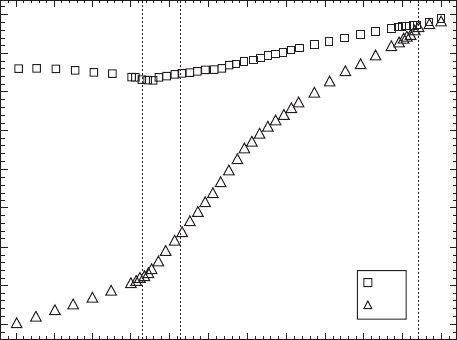
Domains in ferroelectric nanostructures from first principles 587
dipoles in the different (001) planes, as a function of E
z
. As we will see, four
regions can be distinguished, with their electric-field range being indicated
in Figs 19.7 and 19.8 for our film of interest (note that such a range depends
on the film’s thickness and boundary conditions; Lai et al., 2006).
Region I: Fig. 19.8 tells us that, when the electric field is applied from
zero to 33 × 10
7
V/m (Region I), the local dipoles in the ‘down’ domains do
not switch their direction to point along the +z direction (i.e. parallel to the
electrical field) but rather ‘simply’ significantly decrease their magnitude –
while the dipoles in the ‘up’ domains more modestly increase in magnitude.
Such behaviors lead to 〈u
z
〉 and 〈u
M
〉 increasing and slightly decreasing with
E
z
, respectively (see Fig. 19.7), and to domain walls not moving with respect
to the E
z
= 0 case (as shown in Fig 19.2b). Interestingly, Region I (unlike
Regions II, III, and IV, be discussed below) was not found in PZT films
subject to an electric field (Lai et al., 2006), because of the easiness in
rotating dipoles in these latter systems.
Region II: A further increase of E
z
from 33 × 10
7
to 43 × 10
7
V/m (Region
II) induces a switch, from the –z to +z direction, of some dipoles in the down
domains − as indicated by Fig. 19.8 (a) and (c). Such a switch thus results in
U
M
U
Z
I II III
IV
0 102030 40506070 8090100110
E
z
(10
7
V/m)
Local modes (a.u.)
0.040
0.035
0.030
0.025
0.020
0.015
0.010
0.005
0.000
19.7
Supercell average of the
z
-Cartesian component of the local
modes, <
u
z
>, and supercell average of the magnitude of the local
modes, <
u
M
>, as a function of
E
z
for 20Å-thick BTO films under a
compressive strain of –2.2%, a 80% screening of the maximum
depolarizing field, and at
T
=10 K. Square and triangle symbols
display <
u
M
> and <
u
z
>, respectively. The supercell averages of the
x
- and
y
-Cartesian components of the local modes are essentially
null and are not shown for clarity. (Reprinted with permission from
Lai
et al.
, 2007).
WPNL2204
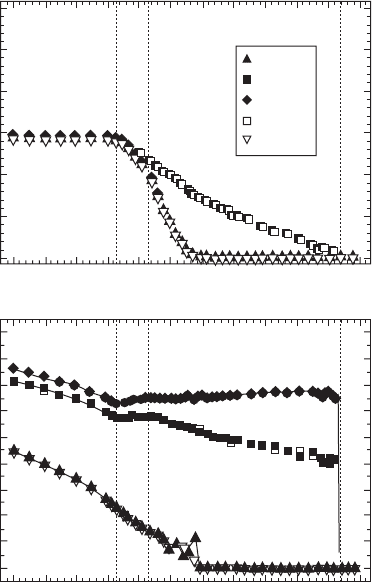
Handbook of dielectric, piezoelectric and ferroelectric materials588
19.8
(a) Number of sites with a negative
z
-Cartesian component of
the local modes and (b) the corresponding <|
u
z
|> average magnitude
of their
z
-Cartesian component of the local modes, as a function of
E
z
, in the different (001) layers at
T
=10 K for 20 Å-thick BTO films
under a compressive strain of –2.2 and a 80% screening of the
maximum depolarizing field. (c) and (d) are the same as (a) and (b),
respectively, but for a positive
z
-Cartesian component of the local
modes. The layer index of thin films from the first layer (layer 1,
which is a surface layer) to the last layer (layer 5, which is the other
surface layer) are indicated via solid triangle, solid square, solid
diamond, open square and reversed open triangle, respectively.
(Reprinted with permission from Lai
et al
., 2007).
an increase of 〈u
z
〉 when increasing E
z
(see Fig. 19.7) and in an expansion of
the majority domains at the expense of minority domains while maintaining
the same overall stripe periodicity – as in the corresponding region for PZT
films (Lai et al., 2006). However, unlike in PZT (Lai et al., 2006) and as seen
in Fig. 19.2(c), this expansion of majority domains is not synchronous
throughout the domain walls. Rather, scattered regions of switched dipoles
(with five lattice constants along the z-axis and one lattice constant along
Layer 1
Layer 2
Layer 3
Layer 4
Layer 5
(a)
I II III IV
0 10203040 5060708090100110
Number of sites with
u
z
< 0
600
500
400
300
200
100
0
(b)
I II III IV
<|
u
z
|>
0 10203040 5060708090100110
0.045
0.040
0.035
0.030
0.025
0.020
0.015
0.010
0.005
0.000
WPNL2204
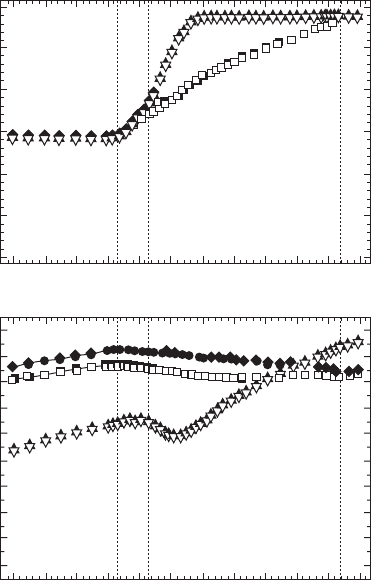
Domains in ferroelectric nanostructures from first principles 589
both the x- and y-axes) that are bounded by (100) and (010) side surfaces
‘pop out’ adjacent to the original domain walls. Therefore, the domain walls
expand along [100] and [010] by one lattice constant at a time, and now
exhibit a zigzag pattern (while these domain walls are straight in PZT films
(Lai et al., 2006). Moreover, the switching behaviors of the dipoles at the
surfaces and inside the films are documented in Fig. 19.8. In particular, one
can see that the dipoles on surfaces are slightly easier to switch than the
dipoles inside the films because they have a smaller magnitude just before
the switching. The real-space distribution of dipoles (data not shown) in
Region II further indicates that the switching of the surface dipoles occurs
through both rotation and flipping mechanisms. The former mainly involves
the dipoles that initially deviate from the z-axis (see Fig. 19.3) and is
accomplished by local dipoles rotating away from the z-axis while decreasing
their magnitude at the same time. The latter applies to the dipoles that were
initially aligned along the z-direction (see Fig. 19.3), is preceded by a decreasing
19.8
(Continued)
(c)
I II III IV
0 10203040 5060708090100110
Number of sites with
u
z
< 0
600
500
400
300
200
100
0
(d)
I II III IV
0 10203040 5060708090100110
<|
u
z
|>
0.045
0.040
0.035
0.030
0.025
0.020
0.015
0.010
0.005
0.000
WPNL2204
